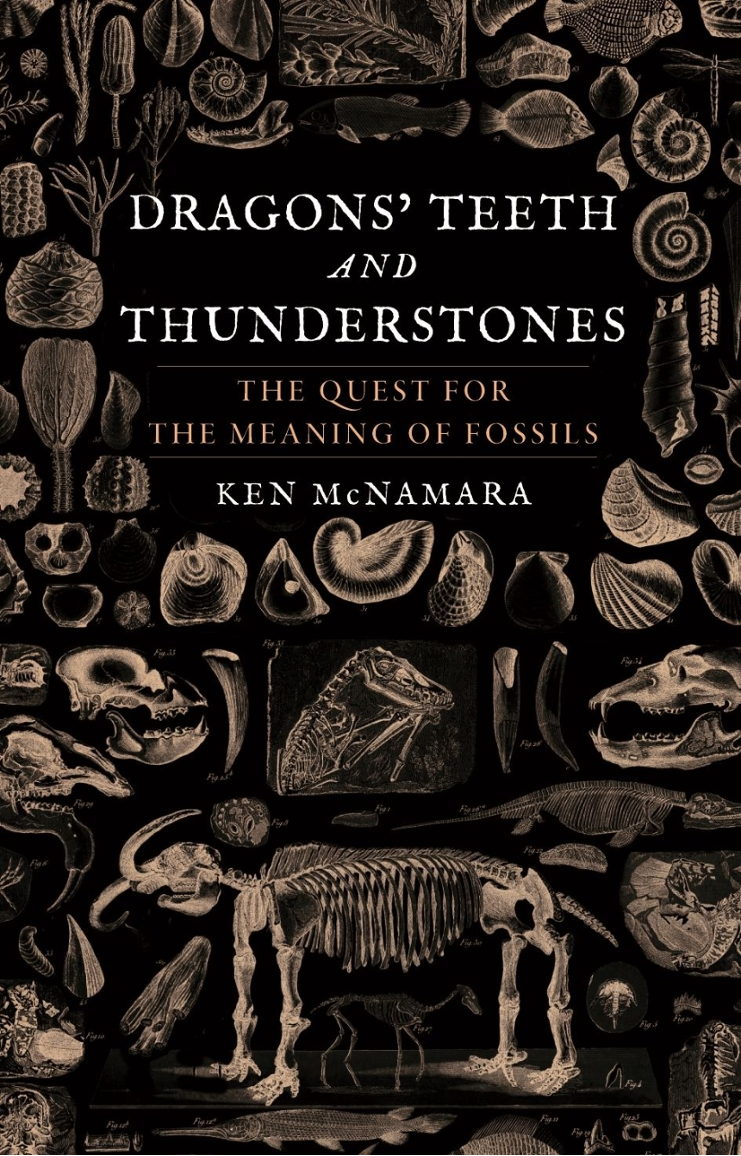Book Review: Dragons’ Teeth and Thunderstones: The Quest for the Meaning of Fossils
Reviewed by Andrej Spiridonov (Vilnius University, Lithuania & Nature Research Centre, Lithuania)

McNamara, Ken. 2020. Dragons’ Teeth and Thunderstones: The Quest for the Meaning of Fossils. Reaktion Press, London, UK; distributed in United States by University of Chicago Press, 288 pp. ($17.50 cloth, $17.50 pdf/e-book with 30% PS discount.)
This book, by renowned paleontologist Ken McNamara, is a very peculiar read. At first glance you think that you are holding a book about the history of science of paleontology as such, but at the closer inspection you can find that it is more of a treatise on the nature of human curiosity towards the fossils in all its instantiations. We are often told during undergraduate courses that the science of paleontology and systematic interest in fossils started during Enlightenment. Yes, there were some excursions here and there during the Classical Period and the Middle Ages. Sometimes they were so close to the truth, but the study of fossils as the traces of ancient life seemingly never caught momentum. The author shows a bit different story: humans always were interested in fossils, and their interpretation of them very much varied.
The approach taken by the author reminds me another book by Adrienne Mayor (2000), where she introduced for a wide audience the term “geomythology”. While Mayor correlated the ancient Roman, Greek and Egyptian myths with the actual vertebrate fossil record available to these ancient civilizations, and sometimes recovered by archaeologists in famous ancient sites, the approach of McNamara is more varied. In his book, he systematically explores how ancient humans, but also some people of almost contemporary time, understood, used, and engaged with fossils, what part of their lives they constituted, and how this meaning evolved with changing cultures.
The book is subdivided into ten chapters, each reflecting some form of human cultural interaction with fossils in historic and prehistoric context. In his book, McNamara shows with many examples that fossils were a timeless obsession for our species since the Paleolithic period. More to that, he reveals there are direct archaeological “second-hand fossil” evidence, that humans of at least two other species (Neanderthals and Hendelbergians, and maybe even Homo erectus) also searched for, adored and used very specific fossils.
You can find a wide discussion on the book of many myths and stories that humans in Europe produced trying to explain strange geometrically organized stones, which we now call sea urchins, belemnites or ammonites. The most common theme is the connection of these fossils with heavenly or underworldly powers. The names that were given for fossils, such as thunderstones or star-stones, show their perceived connections to the gods and spirits. McNamara extensively exposes the stories behind so called Dragon’s Teeth, a general concept that was applied to a variety of mostly Neogene and Quaternary mammalian fossils from China. “Dragon Teeth” were for millennia valued as a traditional medicine and extensively harvested from natural outcrops for centuries. This traditional endeavour even served its part in the formation of modern vertebrate paleontology in Asia, since the remains of some of the first scientifically described extinct elephants, rhinoceri and chalicotheres were obtained from traditional Chinese apothecaries.
When you read the book, you will find not only the myths or legends but also learn about a variety of uses that fossils were subjected to. Fossils were buried together with deceased persons ever since at least the late Pleistocene. Fossils sometimes could be found preserved on the surfaces of stone hand axes of Acheulean culture, suggesting their aesthetic importance for prehistoric humans. The fossil echinoderms marked by star-like patterns had a great significance in many cultures, since it was believed that they gave their possessor protective powers against lightning strikes or evil spirits. McNamara argues that the five-pointed star, an ancient symbol originating from Egypt, most probably was inspired and originated from the same pattern observed on sea-urchins.
Fossils were not only adored and used as protective items. Some of them were used as cures for various ailments and diseases up to modern times. The belemnites while in some parts of the world adored as thunder points, in medieval times were often called Lynx Stones (Lapis Lyncis); based on their color and specific shape, they were believed to represent petrified lynx urine, and thus being useful for curing bladder problems. The fossil teeth of sharks were most often called “tongue stones” or glossopetrae, most often attributed to petrified tongues of snakes, but sometimes to saints. McNamara reveals that in historical times, poisoning was a rather frequent and convenient method of politics, and there was a need to find effective countermeasures. The teeth of Otodus megalodon and other sharks were collected and attached to tree-like artefacts adorned with Christian symbols placed along the food during feasts of noblemen, thus believed to neutralize any venom or poison.
The book also discusses not only positive but also negative associations and uses of fossils. In some cultures, they were used for inducing magic harm, or were belied to originate from actions of devils or evil spirits. Fossils were collected, used, and adorned all over the world from the prairies of North America to the shrublands and deserts of Australia. Anyone who wants to learn our deeper history of interactions with the ancient traces of life should read this interesting and entertaining book.
References:
Mayor, A. 2000. The First Fossil Hunters: Dinosaurs, Mammoths, and Myth in Greek And Roman Times. Princeton University Press, Princeton, NJ.

